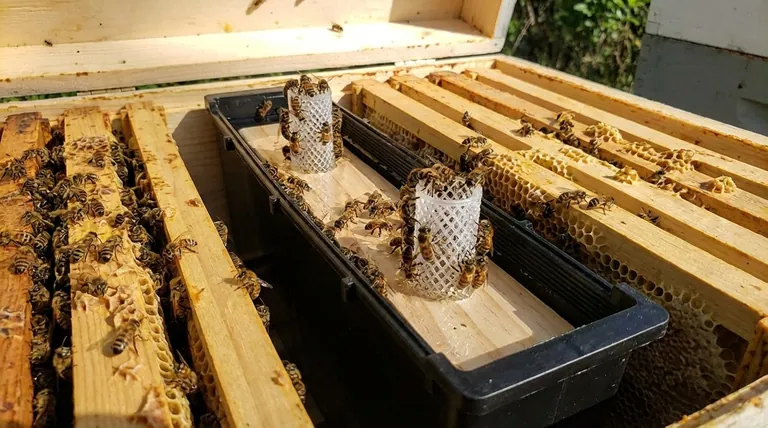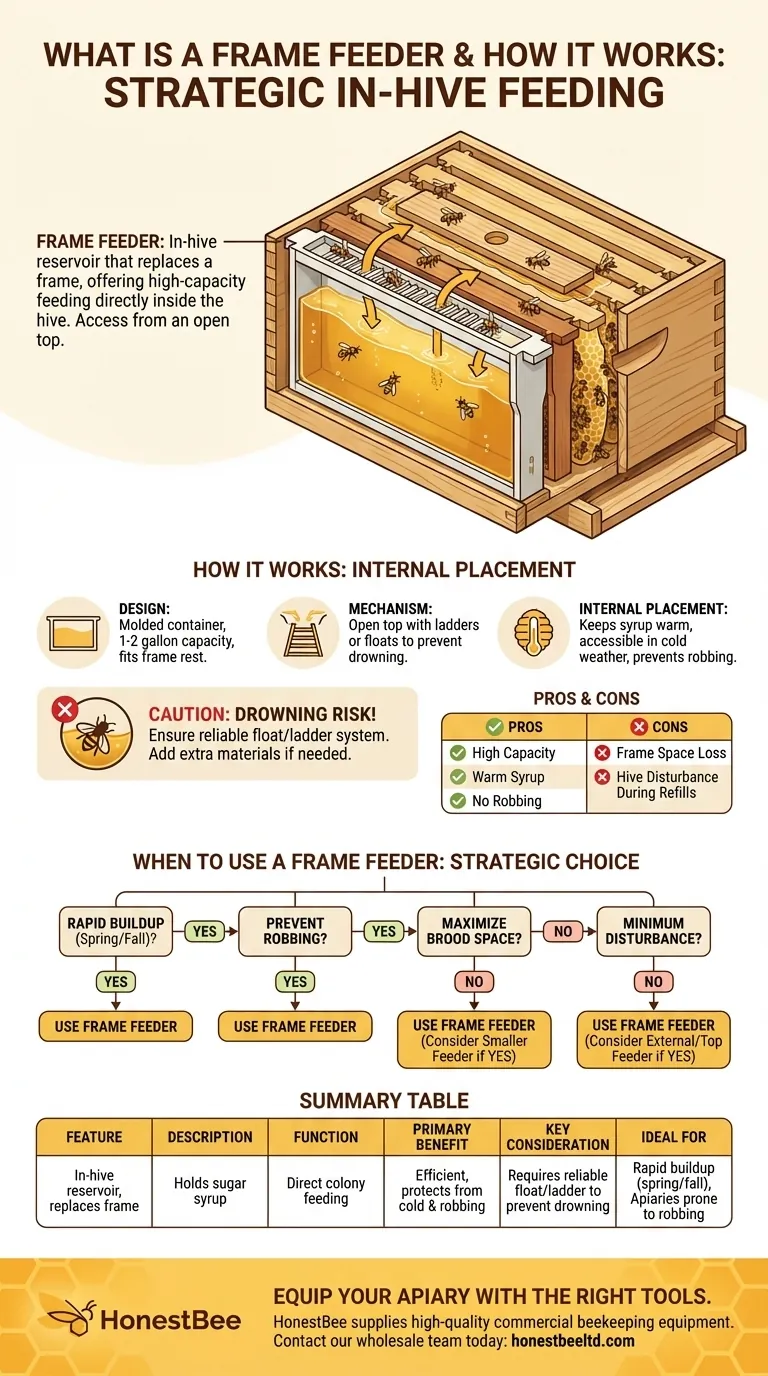A frame feeder is an in-hive reservoir that replaces one or more frames inside your hive body. It is designed to hold a large volume of sugar syrup, allowing you to feed your colony directly within the insulated confines of the hive. Bees access the syrup from an open top, making it a highly efficient method for providing nutrition, especially when outside foraging is not possible.
A frame feeder moves the food source directly inside the hive, offering an efficient, high-capacity feeding solution that protects the colony from cold weather and opportunistic robbers. However, its effectiveness hinges on one critical detail: preventing your bees from drowning.

The Core Function: Bringing the Food Inside
A frame feeder works by integrating a food source directly into the colony's living space. This internal placement is its defining characteristic and the source of its primary benefits.
How a Frame Feeder is Designed
A frame feeder is typically a molded plastic container built to the exact dimensions of a standard Langstroth frame. This allows it to hang from the frame rest inside a hive body or super, just like any other frame.
They are available in various volumes, commonly ranging from one to two gallons. This large capacity reduces the frequency of refills compared to smaller feeder types.
The Feeding Mechanism
The top of the feeder is open, creating a trough that you fill with sugar syrup. To prevent drowning, the feeder must include a system that allows bees to safely reach the syrup.
Many modern feeders have built-in plastic "ladders" or textured interior walls that bees can grip. Others come with a wooden or plastic float that sits on the surface of the syrup, providing a raft for the bees to stand on while they drink.
Why Internal Feeding Matters
Placing the feed inside the hive is a strategic decision. It keeps the syrup warm, making it easier for bees to consume in cold weather without having to break their cluster.
This internal placement also eliminates the risk of "robbing," where bees from other hives discover the food source and attempt to steal it, which can lead to a destructive hive battle.
Understanding the Trade-offs and Risks
While effective, a frame feeder is not a perfect solution. An objective assessment requires understanding its potential downsides.
The Primary Risk: Drowning
By far, the most significant risk associated with frame feeders is bee drowning. If bees fall into the open syrup and cannot climb out, you can lose thousands of workers in a single day.
It is absolutely essential that your feeder has a reliable float or ladder system. Some beekeepers even add materials like straw or twigs to provide extra footholds, but be aware this can make cleaning more difficult.
Sacrificing Frame Space
A frame feeder occupies valuable real estate inside the brood box. By installing one, you are sacrificing space that the queen could use to lay eggs or that workers could use to store pollen and honey.
This is a critical trade-off, especially in the spring when the colony is trying to expand its population rapidly.
Hive Disturbance During Refills
Although a frame feeder reduces the need for frequent intervention, you still must open the hive lid to check the syrup level and refill the trough.
This act breaks the hive's propolis seal and exposes the colony to the outside air, which can be a significant disturbance, particularly in cold or windy weather.
Making the Right Choice for Your Goal
Selecting a feeder depends entirely on your specific objective for the colony at a given time.
- If your primary focus is rapid buildup in early spring or late fall: A frame feeder is an excellent choice, as its large capacity and internal placement deliver nutrition efficiently when bees need it most.
- If your primary focus is preventing robbing in an apiary with many hives: An internal frame feeder is one of the most secure options available, as it conceals the food source from outsiders.
- If your primary focus is maximizing brood space for a new package or nuc: You must weigh the loss of a frame against the colony's need for supplemental feed, perhaps considering a smaller feeder initially.
- If your primary focus is absolute minimum disturbance: An external entrance feeder or a top feeder that can be refilled with less disruption might be a better alternative for your specific management style.
By understanding its specific strengths and weaknesses, you can use the frame feeder as a powerful tool for strategic hive management.
Summary Table:
| Feature | Description |
|---|---|
| Function | An in-hive reservoir that replaces a frame to hold sugar syrup for direct colony feeding. |
| Primary Benefit | Efficient, high-capacity feeding that protects syrup from cold weather and robbing bees. |
| Key Consideration | Requires a reliable float or ladder system to prevent bee drowning. |
| Ideal For | Rapid colony buildup in spring/fall and apiaries where robbing is a concern. |
Equip your apiary with the right tools for success.
A frame feeder is a key piece of equipment for strategic hive management. At HONESTBEE, we supply commercial apiaries and beekeeping equipment distributors with the high-quality, reliable supplies needed to support healthy, productive colonies.
Let us help you optimize your feeding strategy. Contact our wholesale team today to discuss your needs for frame feeders and other essential beekeeping equipment.
Visual Guide

Related Products
- Professional In-Hive Frame Bee Feeder by HONESTBEE
- 3.5L Plastic Beehive Frame Feeder Deep Frame Water Feeder for In Hive Use
- Professional In-Hive Bee Feeder HONESTBEE Frame for Beekeeping
- Professional Hive Front Entrance Bee Feeder
- In-Hive Dual Compartment Frame Bee Feeder for Targeted Colony Nutrition
People Also Ask
- What is a frame feeder? A High-Capacity, Secure In-Hive Feeding Solution
- What are the advantages of using a frame feeder? Boost Hive Health with In-Hive Feeding
- How do frame feeders prevent drowning of bees? Essential Safety Design for Healthy Hives
- What are frame feeders, and what are their advantages? Essential for Cold Weather & Efficient Feeding
- What are the types of internal feeders used in beekeeping? Optimize Your Hive's Nutrition Strategy



















